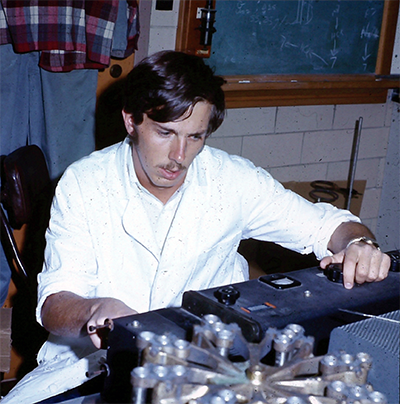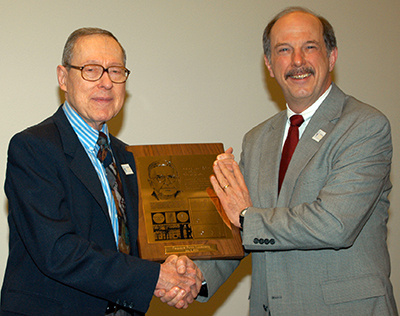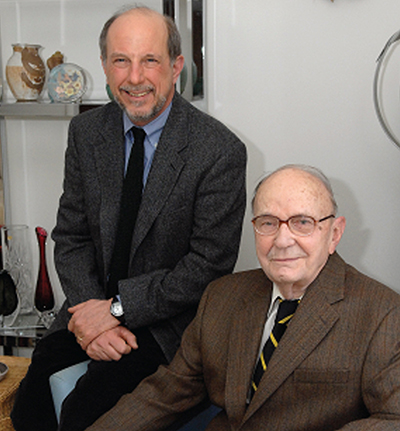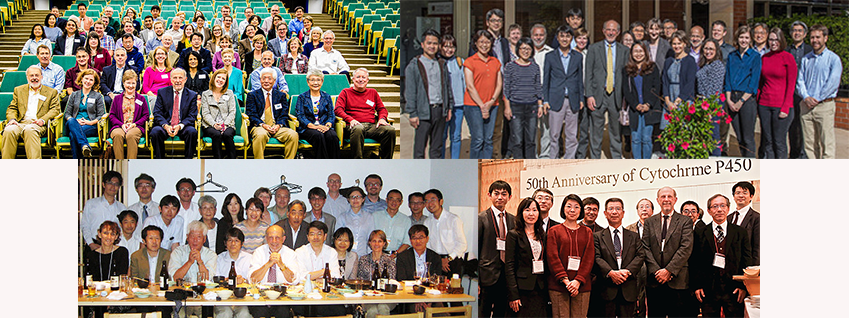Numbers can tell a story. For Fred Guengerich, professor of biochemistry, the story of his 50-plus years in science can be told through his 100 semesters on Vanderbilt University’s faculty; the 22 graduate students and 143 postdoctoral fellows and visiting scientists he has mentored; the 777 primary research papers, 323 invited reviews and chapters, and 138 book chapters and published proceedings he has authored; and the 130,886 of times he has been cited.
But even those numbers don’t tell the whole story.
The early days
Guengerich’s tale began on an Illinois farm on New Year’s Day in 1949. He was the first member of his family to be born in the U.S., as they had migrated from Germany in 1913. Life was grueling for his father, who often worked 100 hours a week, but he inspired in his son a “warm spot in my heart for hard-working immigrants.”

By age 10 Guengerich could operate a tractor. At 12 he was driving stick-shift trucks. Six-day work weeks, exposure to the elements, and no time for vacations ingrained in him a work ethic that has served him well throughout his professional life. “It may not seem very relevant to a career in science, but I learned much about hard work, self-reliance, and mental toughness from my father,” Guengerich said. “Compared to baling hay, working in the laboratory is much easier and much more interesting.”
Guengerich excelled in agriculture and chemistry in high school, but soon realized that following in his father’s footsteps was not in his future. Instead, he enrolled in the University of Illinois to study food science and technology. His sophomore advisor, Carl Davis, saw the potential in him and suggested he apply for summer work in the biochemistry lab of Harry Broquist.
The summer research project involved working on pathways of alkaloid biosynthesis in the mold Rhizoctonia leguminicola, a fungus that affects plants and causes black patch disease in horses and cattle. “Once I started I never wanted to do anything else for a career but be a biochemist,” Guengerich said.
As Guengerich later related in a recollection published in 2005 in IUBMB Life, “I was not aware of this as a student, but people take notice of your good qualities as well as the bad.” His stint with Broquist turned into a lifelong friendship.

Guengerich’s achievements and efforts as an undergraduate were also recognized through the Bronze Tablet—a University of Illinois tradition. However, his full name, Frederick Peter Guengerich, wouldn’t fit on the award plaque, so he opted for “F. Peter Guengerich.” The name stuck and it’s what he has used on academic papers ever since.
Finding his own path
Broquist accepted a faculty position at Vanderbilt in 1969 and Guengerich followed him in 1970, enrolling in graduate school to study biochemistry. He started with a small annual stipend and an individual National Institutes of Health fellowship.

At that time graduate students were required to pass a foreign language exam in either German, French, or Russian. Although his father spoke a Bavarian German dialect with a “thick” accent, Guengerich didn’t learn the language at home. He took an introductory German class, read German chemical and medical journals, and passed the exam on his first attempt.
His last year of graduate school proved to be a memorable one: Guengerich met a “beautiful, red-headed nurse.” He and the nurse, Cheryl Powell, were married in December 1973 shortly after Guengerich started a new job as a postdoctoral fellow. “We have been happy together since then,” he said.
The new job—a position in the lab of Minor J. “Jud” Coon, best known for his research on cytochrome P450—took him from Nashville to the University of Michigan in Ann Arbor, Michigan. It was a fortuitous match that gave Guengerich a lifelong research focus. “It was Jud Coon who really taught me how to be a professor, although I did not always realize it at the time,” Guengerich said.

Cytochrome P450 enzymes are the main catalysts that break down drugs in the body. Variability in these enzymes is a major factor in how long they are active in the body and in drug-drug interactions. Cytochrome P450 enzymes are also the main ones involved in steroid metabolism, and changes in their expression level can cause serious endocrinological problems. “When some are too active, they are targets for cancer-treating drugs such as the aromatase inhibitors for breast cancer,” Guengerich said. “I was attracted by the enzymes because I thought there might be practical applications for P450 research someday, especially if I decided to go into industry, but I did not expect to keep working on the same enzymes for the rest of my life.”
Guengerich completed his Ph.D. in a remarkable three years, and, in 1975—barely five years after obtaining his undergraduate degree—returned to Vanderbilt as an assistant professor. He was promoted to associate professor with tenure five years later and became a full professor—at a young 34—in 1983.

Don’t take it from us—take it from his trainees
The impact of Guengerich’s mentoring can be felt through the work and words of former trainees, many of whom have embarked on their own stellar careers.
“Fred has always maintained an unparalleled love for science,” Asit Parikh, president and CEO of MOMA Therapeutics and former Guengerich lab member, said. “He led by example, as exemplified by his ritual Saturday mornings in the lab where he conducted his own experiments—most unusual for a scientist at his level!” Parikh has been able to lean on his former mentor over the years and appreciates his equanimity not just in science but in regards to people and decision-making. When it comes to the work he expects from his lab members, Parikh said that what Guengerich “wanted to see was effort and excellence in the pursuit of science, whether the science was pure or applied, and he would lend his full support as soon as that bar was achieved” regardless of gender, race, religion, or socioeconomic status. “I am deeply grateful to have him as a friend and mentor,” Parikh said.
Former postdoc Hiroshi Yamazaki, now a professor at Showa Pharmaceutical University, recalls how Guengerich has worked with many international collaborators, students, and postdocs. “He learned much of other cultures through the individuals and gave us great, kind, and continuous support and impact on our training and career,” Yamazaki said.
Laura Furge, Ph.D.’98, a former Guengerich lab graduate student and current provost and professor of chemistry at Muhlenberg College, values Guengerich’s mentorship so much that she has sent six research students to work under him. “Fred has been a constant mentor, colleague, and now friend,” she said. “In 1994, he got me started in research and gave me the confidence to be successful and to push myself. Every morning on my desk there would be new papers to read, manuscript markups, and notes to remind me that I was part of a team.” Even though she has left his lab, Guengerich has been available to celebrate successes and to encourage Furge through challenges. “While my current role as a provost has taken me away from the lab, I’ve tried to model the same level of relentless support for my colleagues that I have felt these past 25 years from Fred.”
Former postdoc Robert Eoff, currently a professor of biochemistry and molecular biology at the University of Arkansas for Medical Sciences, has similar feelings about the impact that Guengerich has had on his life. “Very few people have influenced my life as much as Fred,” he said. “The constancy of his work ethic, intellectual prowess, and drive to have a long-lasting and meaningful body of scientific work are all inspirational.” Eoff also prizes Guengerich’s mentorship, and credits it with helping to hone many of his most valuable professional skills, such as “being consistent in your work, staying organized and ahead of schedule, keeping lines of communication open, and having belief in one’s own abilities—traits I saw him apply every day.”

A lasting legacy
John Exton, professor emeritus of molecular physiology and biophysics, now deceased, once told Guengerich: “You often come back to your lab from committee meetings and wonder if your presence there mattered—usually not.” But as an editor, Guengerich said, “you make the real decisions—decisions that (usually) stick and that can shape an entire research field.” To that point, he joined the editorial board of the Journal of Biological Chemistry in 1984 and eventually became an associate editor. He remains involved with the journal and most recently has served as interim Editor-in-Chief and deputy editor.
Guengerich flirted with fame in 2004 when he and a former postdoc, Elizabeth Gillam, made international headlines by discovering a liver enzyme that turned a bacterium blue. The media speculated on its significance toward the creation of blue roses and blue cotton, which do not occur naturally, but sadly, the potential game changer did not pan out. Regardless, the discovery garnered him a spot in a mid-2000s edition of the popular trivia board game.
When Guengerich began his academic career, most of his peers handwrote articles on legal pads. But unlike most of his peers today, he literally puts pen to the paper when starting new work. “I still write up initial drafts of long things—papers, grants, manuscript reviews—in longhand. As Lubomir Hnilica, a former faculty colleague at Vanderbilt, used to say, ‘I think with my pencil.’” Guengerich’s long-time administrative assistant, Kathy Trisler, then transcribes his work. “When I first started working for Fred in 1999, I was so happy that he preferred to handwrite his letters, manuscripts, etc.,” she said. “I was not very good at transcribing from recordings, but I was fast at typing what I read. So, we were a good fit.”
His handwriting-and-thinking approach is clearly working, seeing as he is one of the most-cited authors in his field. “Dr. Guengerich’s accomplishments in scientific research are extraordinary,” said David Cortez, Richard Armstrong Professor for Innovation in Biochemistry and chair of the Department of Biochemistry. “He is a world leader in the field of cytochrome P450 biochemistry. He has made major contributions to our understanding of cytochromes P450 as central enzymes in metabolic and biosynthetic pathways, xenobiotic processing, drug catabolism, biotechnology, health, and disease.”

When he’s not in the lab or at conferences, Guengerich pursues fishing and photography. He has traveled the world with his camera, from Africa and Antarctica to South America and Oceania. “Photography is interesting for a scientist: it allows you to combine technical skill with art and composition,” he said.
Former postdoc Eoff encapsulates Guengerich’s versatility: “Fred is an exemplary scientist and leader, a devoted husband and father, and a gifted photographer. He even runs a farm!” he said. “I wouldn’t be where I am today without Fred, and I will always be grateful for the opportunity to be one of his [mentees].”
Without a doubt, Guengerich can look back contentedly on his career. “I consider myself a very fortunate person—I am paid to do things I like,” he said. “I owe a lot to biochemistry and have absolutely no regrets.”
Turns out that, in a way, Guengerich did follow in the footsteps of his father: sowing seeds and harvesting the fruits of hard labor.
Read a firsthand, in-depth retrospective of Guengerich’s career, “Ninety-eight semesters of cytochrome P450 enzymes and related topics—what have I taught and learned?” published Jan. 2024 in the Journal of Biological Chemistry.
